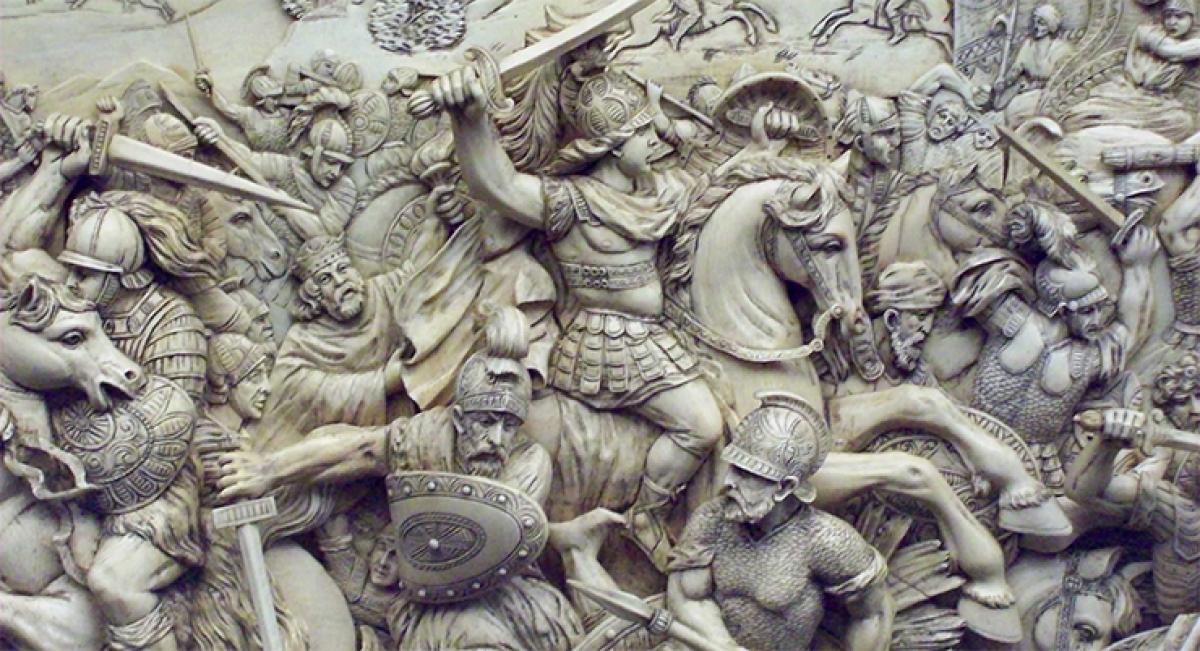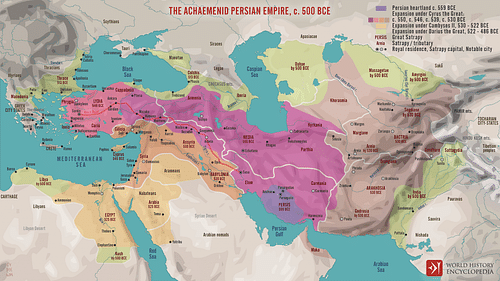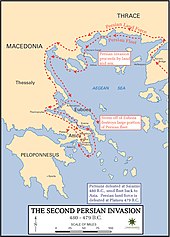
At a time when the states of central India were falling prey to the expansionist policy of the Magadha Empire, there was an atmosphere of extreme political anarchy and disorder in the northwestern region. This region was divided into many small states, for example Madra, Kamboj, Gandhara etc. On the other hand, the fertile valley of the Indus made the region prosperous. The coming together of political instability and prosperity was the biggest temptation for any foreign invader.

Source: As evidence of the early Iranian invasion of Indian territory, we rely on the description of Greek and Roman historians such as Harodotus, Pliny, Strabo, and Arian.
Reasons for Iranian invasion: For the Achaemenid rulers, the victory of the northwestern Indian provinces had no less political as well as economic and strategic significance. In fact, the route of entry into India could have been opened by establishing control over this area. Its economic perspective was that Uttarapath, India's main trade route, passed through this area to Central Asia. Control over this route meant benefiting from the most prosperous sources of terrestrial trade. Therefore, in order to fulfill his imperialist ambitions and to confirm economic interests, Cyrus II appeared for the conquest of Indian territory.

Cyrus II (558-529 BC): In the middle of the sixth century BC, Cyrus-II established the Achaemenid dynasty in Iran. Soon under Cyrus' leadership, the Achaemenid dynasty became the most powerful dynasty in Western Asia. The eastern border of his empire began to touch India. Cyrus-II was an ambitious ruler and decided to conduct military operations on the Indian subcontinent to fulfill the indomitable desire for expansion and wealth gain. Which territories of India Cyrus certainly conquered is not known in the absence of concrete evidence. From the description of Alexander's Chief of Naval Staff, Niercus – protected by Arian and Strabo – we know that Cyrus tried to invade India through the desert of Zedrosia but suffered devastating failures. On the way, his entire army was destroyed and he ran for his life with only seven soldiers. From the description of the Roman writer Pliny, it is known that Cyrus was not disappointed with his initial failure and he invaded India from the Kabul Valley for the second time. This time Cyrus demolished the city of Kapisha. He died fighting against an eastern tribe called Derbike in the Caspian region. After his death, his son Cambyses II (529-522 BC) succeeded his empire. He remained embroiled in civil wars and during his time the Parsic empire could not expand towards India.
Darius I (Dara I) (522-486 BC):
- The expansionist policy on behalf of India by the Iranian rulers got the most rational direction during the period of Darius I. Sources of information on darius I's conquests include descriptions of Greek writers as well as the Behistoon, Persepolis and Nakhsh-e-Rustam records.
- There were 23 provinces under the rule of Dara, in which the names of 'Shatag' and 'Gadar' are found, but the name of India is not there. The word 'Hidu' along with 'Shatagu' and 'Gadar' is mentioned as the province of his empire in the writings of 515. It is clear from this that Shatagu, Gadar and Hidu were involved in the empire of Dara. These three territories were located in the Indus Valley on the eastern border of the Kingdom of Dara.
- Horodotus also confirms the conquest of Darius I, writing that India is the most densely populated region of the Iranian Empire and the empire receives 360 talents of gold.
- Darius' hegemony over the Indus region is also confirmed by the fact that he sent a fleet of ships led by his Chief of Naval Staff Skylex to explore the mouth of the Indus River. Thus Darius empire consisted of the territory of the Indus, whose last extension eastward was to the desert areas of Rajputana.
- Undoubtedly, this conquest of Darius gave political unity to northwest India. After this, India connected to the Western world. His successors did not try to extend the eastern border of their empire beyond this, and they were engaged in securing the territories conquered by Darius.
Xerxes I (486-465 BC):
- Darius successor, Xerxes I, managed to keep the Iranian empire intact in India. In one of his articles from Persepolis, the three regions of India – Gandhara, Shatagu and Sindhu – are clearly mentioned. This reveals that he secured his father's Indian empire.
- He employed a large number of Indians in its army. With the help of this army, he responded to the Greek invaders.
- The period of decay has also been notorious for its policy of bigotry. It is believed that in India, he demolished many temples and ordered people to worship Ahuramajda in exchange for Indian gods.
- After him the Indian territory began to collapse. After his death, his immediate successors were Artaxerxes I and II, respectively|
- However, Iranian rule continued until darius III until the fourth century BC. By defeating this ruler, the world conqueror Alexander ended the Iranian empire.
Effects of the Iranian invasion:
- Political consequences: If the impact of the Iranian invasion on Indian territory is assessed, it is known that it did not yield any concrete political results. The Iranian invaders were able to dominate only the northwestern terrain. Since this victory was also short-lived, the region remained almost unaffected politically. Yes, it did happen that this invasion exposed the hollow immune system of india's frontier territories, as a result of which Alexender The great also got inspiration to attack north-west India. After the Iranians, the Greeks, Shakas, Kushans and Huns were also inspired to
- Administrative influence: The short-term Iranian administrative system affected the Indian administrative system to some extent. These effects are reflected in the Mauryan administration. Under Maurya, the appointment of female bodyguards in security, dividing the empire into different regions, etc. have been accepted as Iranian influences. Iranian influence is also seen on the preamble of Ashoka's decrees.
- Economic Impact: The north-west Indian territory came under the control of the Iranian Empire. As a result, it became connected to a large business network. Therefore, during this period, the urban economy and currency system were encouraged in the north-west. Connectivity between Iran and India also resulted in encouragement of geographical discoveries. During the time of Darius I, Skylax found a sea route from India to the Western countries, due to which Indian traders started moving to western countries and their goods started reaching far away Egypt and Greece. Iranian coins from the Northwestern Frontier Province confirm the close trade relations between India and Iran. Iran's common currency have been found from northwestern parts of India.
- Cultural influence:
- As a result of Iranian contact, a new script called Kharoshti, written from right to left in India, was born by the combination of Indian and Iranian Aramaic script in the northwestern regions of India. Mauryan ruler Ashoka also got the large inscriptions of Manshehra and Shahbazgarhi inscribed in Kharoshti script keeping in mind the regional need. Iranian influence has also been accepted on the practice of maurya rulers getting their orders inscribed on a huge pillar.
- Indian scholars and philosophers became familiar with Western knowledge and science. Greeks like Skylax visited India and historians like Herodotus and Tessius collected important information for their texts.
- The influence of Buddhism on the Zoroastrianism of ancient Persia was clearly seen .
- Some scholars outline Iranian influence on Mauryan architecture. The maurya emperors followed the court glory and some traditions of the Parsic kings. Many Parsic elements can be clearly seen in the palace of Chandragupta Maurya with huge pillars found in the excavation of Pataliputra. It is possible that Ashoka derived the style of carving the government order on the rocks from the writings of Dara I. It is believed that the pattern of the bell-shaped dome above the pillars and the shiny polish, which was an important feature of Mauryan architecture, was derived from Persian architecture. However, there is no consensus among scholars on this subject.
- For the first time, the Iranians used the word 'Hind' for the Indian territory. In the record of Darius-I, Hidus was discussed in the context of those who were residents of the Indus River Valley region.
- Persian silver coins were in circulation in India. This had an impact on the Indian currency. Persian coins were known for their sophisticated casting and elegant look. Indian rulers adopted similar techniques to mould their coins on the Persian model.
- A large number of foreigners, Greeks, Persians, Turks, etc. settled in the north-western parts of India. With the passage of time, they were completely absorbed into indians.
Thus, the Iranian invasion may not have had a wide political impact, but the cultural and economic implications are significant.
No comments:
Post a Comment